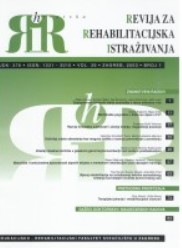Morfološke pogreške u diskursu djece s PJT
Morphological Errors in Discorse of Children with SLI
Author(s): Diana Arapović, Maja AnđelSubject(s): Theoretical Linguistics, Morphology, Syntax, Psycholinguistics, Sociolinguistics, Cognitive linguistics, South Slavic Languages, Cognitive Psychology
Published by: Sveučilište u Zagrebu, Edukacijsko-rehabilitacijski fakultet
Keywords: children with specific language impairments; morphological errors;
Summary/Abstract: The notion of Specific Language Impairment (SLI) refers to children whose language skills are in disproportion with their chronological age and their non-verbal skills, for unknown reasons and in any (one or more) part of their linguistic development (Bishop, Adams I99I ). SLI children may have phonological and pragmatic language difficulties, but the most affected part of grammar in SLI children seems to be morphosyntactic. Morphology is the part of the language in which the grammar of a language system becomes clearly perceptible, therefore it is especially important when we try to assess the level of language skills. In this paper we have tried to present the level of morphology acquisition in children with SLI, taking into consideration the morphological complexity of the Croatian language. We have examined morphological errors in 5 I children with SLI, age from 4,2 to 8. Our results show that most errors appear, in categories of inflexion and congruency, i.e. inappropriate case endings for nouns, auxiliary omissions for verbs and morphological incompatibility of noun+adjective combinations. These results suggest that children with SLI are not able to communicate the contents of information and accomplish its correct grammatical form at the same time.
Journal: Hrvatska revija za rehabilitacijska istraživanja
- Issue Year: 38/2003
- Issue No: 1
- Page Range: 11-16
- Page Count: 6
- Language: Croatian

